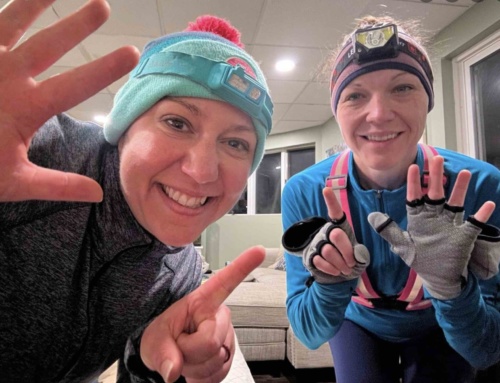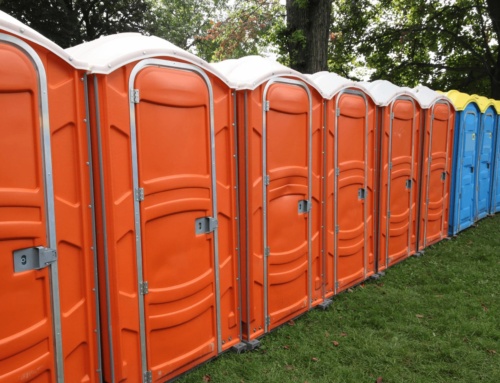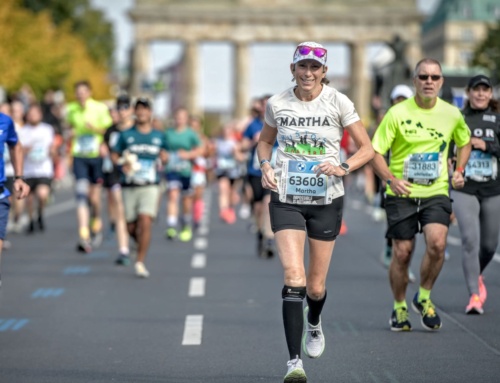This post is by Cay Miller, a longtime member of the AMR community who lives in Arkansas and is an OrangeTheory coach. Last month, Cay and her husband summited Mt. Kilimanjaro, Africa’s highest summit.
Climbing Kilimanjaro was the hardest thing I have ever done. Forty miles of hiking to 19,341’ above sea level and back down in five days is no joke.
Our guided group took the Marangu route, considered to be the easiest route, and the only one with huts for sleeping. Our first hike was five miles through the rainforest. Tree branches, loaded with orchids and other epiphytes, covered the trail; we could hear frogs and birds in the dense foliage.
The rainforest abruptly fell away to shrubby heath and moorland vegetation on our second day of hiking. We still couldn’t see Uhuru Peak, but the open landscape revealed its sister peaks, Kibo and Mawenzi. This seven-mile stretch was my favorite, due to the abundance of flowers, birds, and mountain streams. We finished the day at 12,000+ feet of elevation. Whew!

The third and fourth days blended together. The hike to Kibo took us through an alpine desert dotted with volcanic boulders—a vast, starkly beautiful landscape. Despite clouds rolling through the sky, we could finally see our destination, Uhuru Peak! Hiking continued to become more arduous due to the altitude.
The general plan is to arrive at Kibo Hut, eat lunch, nap for a couple hours, eat dinner, try to nap some more, wake up at 10:00 p.m., then eat something before summiting. Here’s what really happened: We shared the hut with other groups. No one got any sleep. At 15,400’ of elevation, no one had any appetite. I added peanut butter to my porridge to make it more calorie dense. So much for rest and fueling before the summit.

The summit hike begins through a scree field that yields to rocks requiring longer, higher steps. The sound of my boots, the shock of cold air in my nostrils, the illumination of my husband’s boots in front of me, the internal thumping of my elevated heart rate, and my increasingly cold fingers became my primary sensory inputs. In the dark without distractions, doubts and negativity crept in: I should have done more actual hiking at a brisk pace with my trekking poles, plus some practice bouldering.
Breathing became so difficult. A brief stop offered a welcome break and a chance to see a spectacular 360-degree panoramic sunrise with the golden sun sandwiched between two layers of clouds, over dark terrain and white snow. The hike continued along the rim of the volcanic crater. Suddenly, I could see Uhuru Peak right in front of us—we were almost there!

The time at the summit went by quickly. We hugged, cried, and took photos, then started our descent. Climbing down rocks, then hiking down through the deep scree, was much more difficult than I anticipated, especially due to lack of sleep and oxygen.

The final day was a 12-mile hike to the base of the mountain. Cumulative fatigue took its toll, and it was slow going until a rainstorm struck. The downpour turned the hiking paths into creeks—suddenly, I felt like a kid playing in the rain! I was rejuvenated for the final miles of our descent and finished with blisters on my feet—and a smile on my face.






I was looking at hiking Kilimanjaro in May with my daughter but we found out it is the rainy season. It is in my bucket list. How did you train for it?
I came here to ask the same. We are hiking the Lomosho route in January with my Wilderness Medicine group. Any training and gear recommendations please? Seems like I am going to need to go shopping for new cold weather gear and hiking poles.
Thank you for sharing this. What an experience. thank you for the photos as well. Where do you begin to train for such a climb with the elevation etc.?